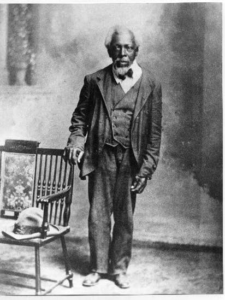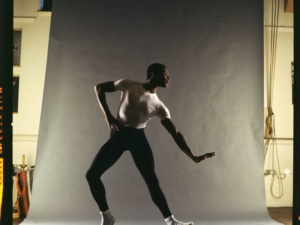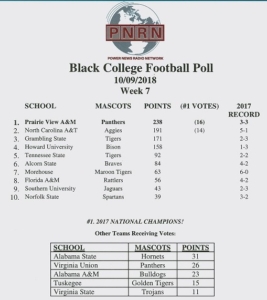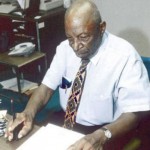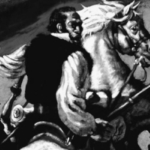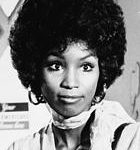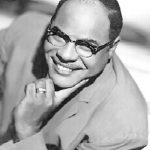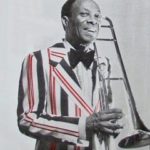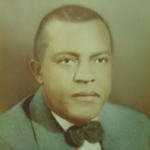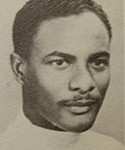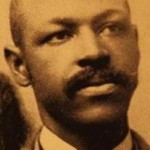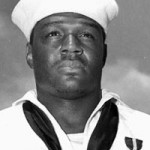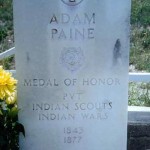Texas barbecue history began with the San Felipe Trail
Photo: The Fourth Ward building at 138 W. Gray, where long ago “barbecue baron” Matt Garner once made and sold his barbecue. (Photo by J.C. Reid / For the Chronicle)
(Houston Chronicle) In antebellum Texas, the cotton plantations along the Brazos and Colorado were worked by African slaves brought there by landowners from states such as Mississippi and Alabama. After the end of the Civil War and the issuance of the Emancipation Proclamation, former slaves traveled east along the San Felipe Trail, settling just outside downtown Houston, along the stretch of the trail which is now West Dallas Street.
This area, known as Freedmen’s Town, became the center of Houston’s African-American community starting in the late 1800s. It also became the center of Houston’s own tradition of Southeast Texas-style barbecue that combined Southern U.S. cooking traditions brought here by slaves, as well as Cajun and Creole techniques brought here from Louisiana. (more)
Tour will honor formerly enslaved man who became a ‘brilliant’ Dallas real estate businessman
(Dallas News) The name Anderson Bonner used to mean something — something “magic” — in Dallas.
Bonner was born enslaved around 1839 and came to Dallas from Alabama as the property of a family of white settlers. He grew into a physically small man who could not read or write his name.
But after slavery ended, Bonner amassed about 2,000 acres in Far North Dallas — likely the largest real estate holdings of any black person in the Dallas area, historians say.
“He may not have looked the part but was a brilliant businessman whose name at the time was magic,” said George Keaton Jr., founder and director of Remembering Black Dallas.
On Oct. 20, Keaton will lead a tour of Bonner’s former holdings as part of his group’s African-American Heritage Tour of North Dallas. Keaton said his goal for the tour is to bring well-deserved but elusive recognition for a black Dallas pioneer whose achievements aren’t well known today. (Note: The Anderson Bonner Endowment scholarship helps Richardson public school students attend Prairie View A&M University.) (more)
Remembering Arthur Mitchell, the Barrier-Breaking Black Ballet Dancer
Mitchell joined the New York City Ballet in 1955 and later founded the Dance Theater of Harlem
(Smithsonian.com) When “Agon” the trailblazing contemporary ballet by master choreographer George Balanchine premiered in 1957, it wasn’t only the performance’s demanding choreography that shocked audiences. Balanchine’s central pas-de-deux in the ballet was crafted especially for two leading dancers at the New York City Ballet: Diane Adams and Arthur Mitchell. Adams was white. Mitchell was black. In those early years of the Civil Rights Movement, the pairing was scandalous.
“Can you imagine the audacity to take an African-American and Diana Adams, the essence and purity of Caucasian dance, and to put them together on the stage?” Mitchell recalled earlier this year, in an interview with Gia Kourlas of the New York Times. “Everybody was against [Balanchine].”
The esteemed performer died (on Sep. 19) at the age of 84; according to Sarah Halzack of the Washington Post, the cause of death was renal failure. (more)
“We’re No. 1!” — PVAMU tops Black College Football Poll
The Prairie View A&M Panthers are sitting atop this week’s Power News Radio Network Black College Football Poll. The Panthers, with a 3-3 record, totaled 238 points including 16 first place votes with North Carolina A&T (5-1) in second place with 191 points, 14 for first place.
The Panthers have won two straight games, including a 22-16 win over Grambling two weeks ago in the State Fair Classic. Grambling was the PNRN preseason No. 1-ranked team.
Prairie View also leads the Southwestern Athletic Conference West standings with a 2-0 record and faces Southern University (2-3) this weekend in the Panthers’ first home game of the season. The Jaguars are tied with Grambling — both with 1-1 records — for second place in the SWAC West.
The PNRN poll is in its first year replacing the Sheridan Broadcasting Network Poll that, since 1990, had also selected Black College All-American Teams and national championship teams under the direction of Ty Miller, manager of news and sports. Sheridan discontinued its services after last year’s season and Miller filled the void with PNRN — the Urban Buzz — which provides urban news and sports content for Black radio stations nationwide.
TIPHC Bookshelf
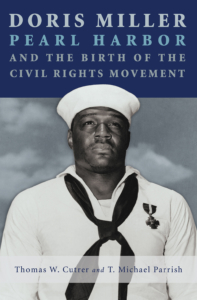 Published scholarship on black history in Texas is growing and we’d like to share with you some suggested readings, both current and past, from some of the preeminent history scholars in Texas and beyond. We invite you to take a look at our bookshelf page – including a featured selection – and check back as the list grows. A different selection will be featured each week. We welcome suggestions and reviews. This week, we offer, “Doris Miller, Pearl Harbor, and the Birth of the Civil Rights Movement,” by Thomas W. Cutrer and T. Michael Parrish.
Published scholarship on black history in Texas is growing and we’d like to share with you some suggested readings, both current and past, from some of the preeminent history scholars in Texas and beyond. We invite you to take a look at our bookshelf page – including a featured selection – and check back as the list grows. A different selection will be featured each week. We welcome suggestions and reviews. This week, we offer, “Doris Miller, Pearl Harbor, and the Birth of the Civil Rights Movement,” by Thomas W. Cutrer and T. Michael Parrish.
On the morning of December 7, 1941, after serving breakfast and turning his attention to laundry services aboard the USS West Virginia, Ship’s Cook Third Class Doris “Dorie” Miller heard the alarm calling sailors to battle stations. The first of several torpedoes dropped from Japanese aircraft had struck the American battleship. Miller hastily made his way to a central point and was soon called to the bridge by Lt. Com. Doir C. Johnson to assist the mortally wounded ship’s captain, Mervyn Bennion. Miller then joined two others in loading and firing an unmanned anti-aircraft machine gun—a weapon that, as an African American in a segregated military, Miller had not been trained to operate. But he did, firing the weapon on attacking Japanese aircraft until the .50-caliber gun ran out of ammunition. For these actions, Miller was later awarded the Navy Cross, the third-highest naval award for combat gallantry.
Historians Thomas W. Cutrer and T. Michael Parrish have not only painstakingly reconstructed Miller’s inspiring actions on December 7. They also offer for the first time a full biography of Miller placed in the larger context of African American service in the United States military and the beginnings of the civil rights movement.
Like so many sailors and soldiers in World War II, Doris Miller’s life was cut short. Just two years after the attack on Pearl Harbor, Miller was aboard the USS Liscome Bay when it was sunk by a Japanese submarine. But the name—and symbolic image—of Dorie Miller lived on. As Cutrer and Parrish conclude, “Dorie Miller’s actions at Pearl Harbor, and the legend that they engendered, were directly responsible for helping to roll back the navy’s then-to-fore unrelenting policy of racial segregation and prejudice, and, in the chain of events, helped to launch the civil rights movement of the 1960s that brought an end to the worst of America’s racial intolerance.”
This Week in Texas Black History
Oct 7
George McElroy, “Mr. Mac”, the first black columnist for the Houston Post, died on this day in 2006. A Houston native, McElroy was also the first African-American to earn a master’s degree in journalism from the University of Missouri, which he attended on a scholarship from the Wall Street Journal. McElroy began his career at age 16 earning $2 a week writing a youth column for the Houston Informer, the city’s oldest black newspaper. Years later, he became the paper’s executive editor. McElroy, the recipient of numerous honors, taught journalism at Houston’s black high schools, as well as Texas Southern University (his alma mater) and the University of Houston.
Oct 9
On this day in 1835, Samuel McCulloch, a free black man, participated in the first offensive action of the Texas Revolution, in Goliad, and is considered the war’s first casualty. McCulloch was born on Oct. 11, 1810 in Abbeville, South Carolina and came to Texas with his father, who was white. McCulloch joined the Matagorda Volunteer Company as a private and was severely wounded in the right shoulder during the Goliad confrontation as the Texans stormed the Mexican officers’ quarters. McCulloch was the only Texan wounded in the battle.
Oct 10
Singer and actress Teresa Graves died in a fire at her Hyde Park (Los Angeles) home on this day in 2002 at age 54. Graves, a Houston native, was a regular on “Rowan & Martin’s Laugh-In” comedy show in 1969 and 1970. She also starred in the television police drama “Get Christie Love” in 1974-75, making her the first black actress to have her own hour-long dramatic TV series.
Oct 10
On this day in 1914, Ivory Joe Hunter, R&B singer and songwriter was born in Kirbyville. Hunter was a teenager when he began touring as a musician. His first of several hit songs was “I Almost Lost My Mind,” which topped the R&B charts in 1950 and later that year “I Need You So” reached number 2. In 1957, “Since I Met You Baby” reached No. 1 and “Empty Arms” reached No. 2. Later in his career, he turned to country and western music and regularly appeared at the Grand Old Opry. A prolific songwriter, it’s estimated that Hunter penned more than 7,000 songs. Elvis Presley recorded two of Hunter’s songs that made the Top 20, “My Wish Came True” and “Ain’t That Loving You Baby.” And, in 1970, Sonny James cover of “Since I Met You Baby” was No. 1 on the country charts. Hunter is honored as a music legend in the Museum of the Gulf Coast’s Music Hall of Fame in Port Arthur. A Texas Historical marker honoring Hunter was erected near Magnolia Springs in Jasper County in 2009.
Oct 10
Milt Larkin, bandleader and self-taught jazz trumpeter, was born on this day in 1910 in Navasota. Larkin began playing trumpet at age 16 and only 10 years later formed his own band in Houston after playing with Chester Boone. Larkin’s group, known as “the last of the great Texas bands,” included saxophonists Illinois Jacquet and Arnett Cobb and was compared favorably with Jimmie Lunceford and Cab Calloway. His popularity grew in New York where he led house bands at the Apollo Theater and the Celebrity Club.
Oct 11
On this day in 1930, Clifton Richardson founded and became editor/publisher of the Houston Defender, a weekly newspaper focusing on the city’s black community. Richardson had the same roles in 1919 with the Houston Informer. He was also a vocal supporter of civil rights and was a founding member of the Civic Betterment League (CBL) of Harris County and founding member and later president of Houston’s NAACP chapter.
Oct 12
On this day in 1950, Herman A. Barnett, III, an Austin native, enrolled as a regular student of the University of Texas Medical Branch in Galveston becoming the school’s first black student. However, in the previous year, Barnett had been accepted to the school but as a student in Houston at Texas State University for Negroes (now Texas Southern University), attending UTMB under a contract program between the schools. The program was stopped after the Veterans Administration (Barnett’s tuition was covered by the GI Bill) refused to recognize the contract system and Barnett’s attorney threatened legal action. Barnett became a prominent surgeon and anesthesiologist and was a graduate of Huston College (now Huston-Tillotson University) in Austin. During WWII, he was a Tuskegee Airman(332nd Fighter Group) and in 1968, became the first African-American to serve on the Texas State Board of Medical Examiners. In 1973, he was the first black elected president of the Board of Trustees of the Houston Independent School District.
Oct 12
Physician Monroe Alpheus Majors was born on this day in 1864 in Waco. Majors was also a civil rights leader and writer. He attended Tillotson College (now Huston-Tillotson University) in Austin, but graduated from Central Tennessee College in Nashville then enrolled at Meharry Medical College and graduated as salutatorian of his class in 1886. He was one of the founders of the Lone Star State Medical, Dental, and Pharmaceutical Association, one of the first medical societies in the country for black physicians. In 1888, fearing for his life after racist threats because of his influence in the community, he moved to Los Angeles and became the first black physician to practice medicine west of the Rocky Mountains. He returned to Waco in 1890 to practice medicine and serve as lecturer in hygiene and sanitation at Paul Quinn College, and also built and operated a hospital for blacks. As a writer, he published Noted Negro Women (1893), a book of biographies of prominent black women of the period, and in 1921 wrote First Steps and Nursery Rhymes, the first book of nursery rhymes written specifically for black children.
Oct 12
On this day in 1919, Pearl Harbor hero Doris (Dorie) Miller was born in Waco. Miller was a mess man aboard the USS West Virginia when the Japanese attacked on Dec. 7, 1941. Miller moved several wounded sailors to safety and then manned an anti-aircraft gun, for which he had no training, and fired at attacking planes. For his actions, Miller was the first African-American to be awarded the Navy’s second highest honor, the Navy Cross. (Note: Please see TIPHC Bookshelf for “Doris Miller, Pearl Harbor, and the Birth of the Civil Rights Movement.”)
Oct 13
In 1875, on this day, Adam (or, “Adan”) Paine (1843-1877), a black Seminole, was awarded the Congressional Medal of Honor. Paine was a scout at Fort Duncan, Texas, and received the MOH for his actions during a battle at Quitaque Peak where he defended himself and four other scouts against several bands of Comanche Indians on September 26, 1874. Greatly outnumbered, the scouts fled, fighting as they went, though Paine held back to protect the others, allowing them to get away as he fired repeatedly at their pursuers. Payne’s horse was shot from under him, however, Paine continued to fight and eventually shot the rider of one horse, mounted the animal and made his escape. Thanks to his efforts during the engagement, all of the scouts survived. Paine’s commanding officer, Colonel Ranald S. Mackenzie, said that Paine “has more cool (and) daring than any scout I have ever known.”
Oct 13
On this day in 1864 the Elm Creek Raid occurred, during which a band of several hundred Kiowa and Comanche Indians raided a settlement in the Elm Creek Valley (northwest of Dallas and South of Wichita Falls) where Britt Johnson, a ranch foreman and former slave, and his family lived. During the raid, Johnson’s son, Jubal, was among several settlers killed. Johnson’s wife, Mary, and two daughters were among the hostages taken into Indian Territory (Oklahoma). Johnson spent the next year traveling into the Territory and finally locating his family. Johnson worked with Comanche Chief Asa-Havey to pay a ransom and regain his family. The story of Johnson’s quest (fact or fiction) was the inspiration for Alan LeMay’s 1954 novel, The Searchers, which director John Ford would turn into a movie of the same name in 1956 starring John Wayne.
Blog: Ron Goodwin, Ph.D., author, PVAMU history professor
Ron Goodwin is an assistant professor of history at Prairie View A&M University. Even though he was a military “brat,” he still considers San Antonio home. Like his father and brother, Ron joined the U.S. Air Force and while enlisted received his undergraduate degree from Texas Lutheran University in Seguin, Texas. After his honorable discharge, he completed graduate degrees from Texas Southern University. Goodwin’s book, Blacks in Houston, is a pictorial history of Houston’s black community. His most recent book, Remembering the Days of Sorrow, examines the institution of slavery in Texas from the perspective of the New Deal’s Slave Narratives.
Recent Posts
The revolution “was” televised
Fifty years ago, black revolutionaries adopted the phrase “the revolution will not be televised” in response to the vast social upheaval of the 1960s. Many Vietnam War protestors believed the new medium of television would be the venue that illustrated the change in American democracy. However, black revolutionaries believed television would not capture the full essence of the movement because the changes that must occur in this society will be live and not scripted by…(more)
Democratic Party – Fifty Years Later
In 1968, the Democratic Party met in Chicago to nominate its candidate for president. The Party was in chaos after the violent deaths of Robert Kennedy and Martin Luther King, Jr. While King was not an acknowledged political figure, his non-violent social stance and his views on American involvement in Vietnam was influencing public policies. Perhaps more influential in the forthcoming implosion of the Democratic Party was the death of Robert Kennedy. His politics of…(more)
Submissions wanted
Historians, scholars, students, lend us your…writings. Help us produce the most comprehensive documentation ever undertaken for the African American experience in Texas. We encourage you to contribute items about people, places, events, issues, politics/legislation, sports, entertainment, religion, etc., as general entries or essays. Our documentation is wide-ranging and diverse, and you may research and write about the subject of your interest or, to start, please consult our list of suggested biographical entries and see submission guidelines. However, all topics must be approved by TIPHC editors before beginning your research/writing.
We welcome your questions or comments. Please contact Michael Hurd, Director of TIPHC, at mdhurd@pvamu.edu.

